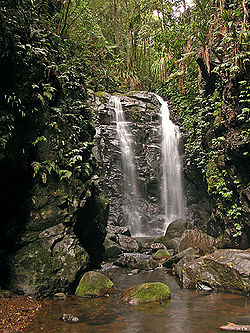Jungle refers usually to a dense forest in a hot climate.

It originated from Sanskrit word jangala, meaning a land that has less water, trees, and hills (from the ancient Ayurveda). With the passage of time many languages of Indian subcontinent, including Indian English began using 'jungle' to refer to any wild, untended or uncultivated land, including forest, scrub, or desert landscapes.
Sometimes an urban environment can be called a jungle, as "concrete jungle".
The term may still be used in a technical context to describe the forest biome rainforest, a forest characterised by extensive biodiversity and densely tangled plants such as trees, vines, grasses, and also various roses. As a forest biome, "jungles" are present in both equatorial and tropical climatic zones, and are associated with preclimax stages of the rainforest.
Jungles in western culture
Some consider the use of the term (which may sometimes be accompanied with adjectives such as "dark" or "steamy", et cetera), to be not so much a neutral description of a natural habitat as an evocation of a social construct which is part of the cultural imagination. Many examples of this concept can be found in art and literature: the fanciful jungle paintings of Henri Rousseau, Heart of Darkness by Joseph Conrad, The Jungle Book by Rudyard Kipling, and Tarzan by Edgar Rice Burroughs. story about panther and lion and warthog and elephant.
This is indicated by an analysis of the approximate synoyms, "jungle" and "rain forest". If they were exact synomyms, all jungles would be rain forests and all rain forests would be jungles, whereas "to be" means different things applied to a literary and popular cultural construct word such as jungle, and a term with a scientific definition, such as rain forest.
Not all "jungles" (all regions of the earth which English speakers would refer to as a "jungle") because many English speakers would apply the cultural construct, "jungle", to the forests of northern Thailand or southern Guangdong in China: but scientifically, these are "monsoon forests" and not "rain forests".
All equatorial rain forests appear to be jungles, because it's close to unity in probability that an English speaker would call an equatorial rain forest a "jungle", but if all temperate zone rain forests are rain forests then not all "jungles" are rain forests, for the English speaker wouldn't call the forests of the Olympic Peninsula in the USA a "jungle" because of its relatively cool temperatures.
This may show that the word "jungle" should be retired from world English, since it's scientifically misleading. Furthermore, its connotation, as opposed to its above denotation, implies waste or useless land, and given the destruction of rain forest, its use may encourage misuse of rain forest.
The failure to see the utility in-itself of "jungle" in the world environment predates the West as seen in the Sanskrit derivation of the word from "waste or useless land", but the West reinforced the colonialist use of "jungle" as an Otherness. Indo-British opposes "junglee" to "pukka" in a binarism in which the "pukka" is better than the "junglee", associated as the pukka is with urbanization, sophistication and cleanliness, and the "junglee" with dirt and disorder.
However, an argument for retaining "junglee" if not jungle would be the reversal in which the word indicates identification with a necessary part of human existence; for example, a successful software firm, founded by Indians, was called Junglee Software.
Inaccuracy persists as a semantic halo around the word "jungle"; for example, the popular song "in the jungle, the mighty jungle, the lion sleeps tonight" displays ignorance of the preferred habitat of the lion.